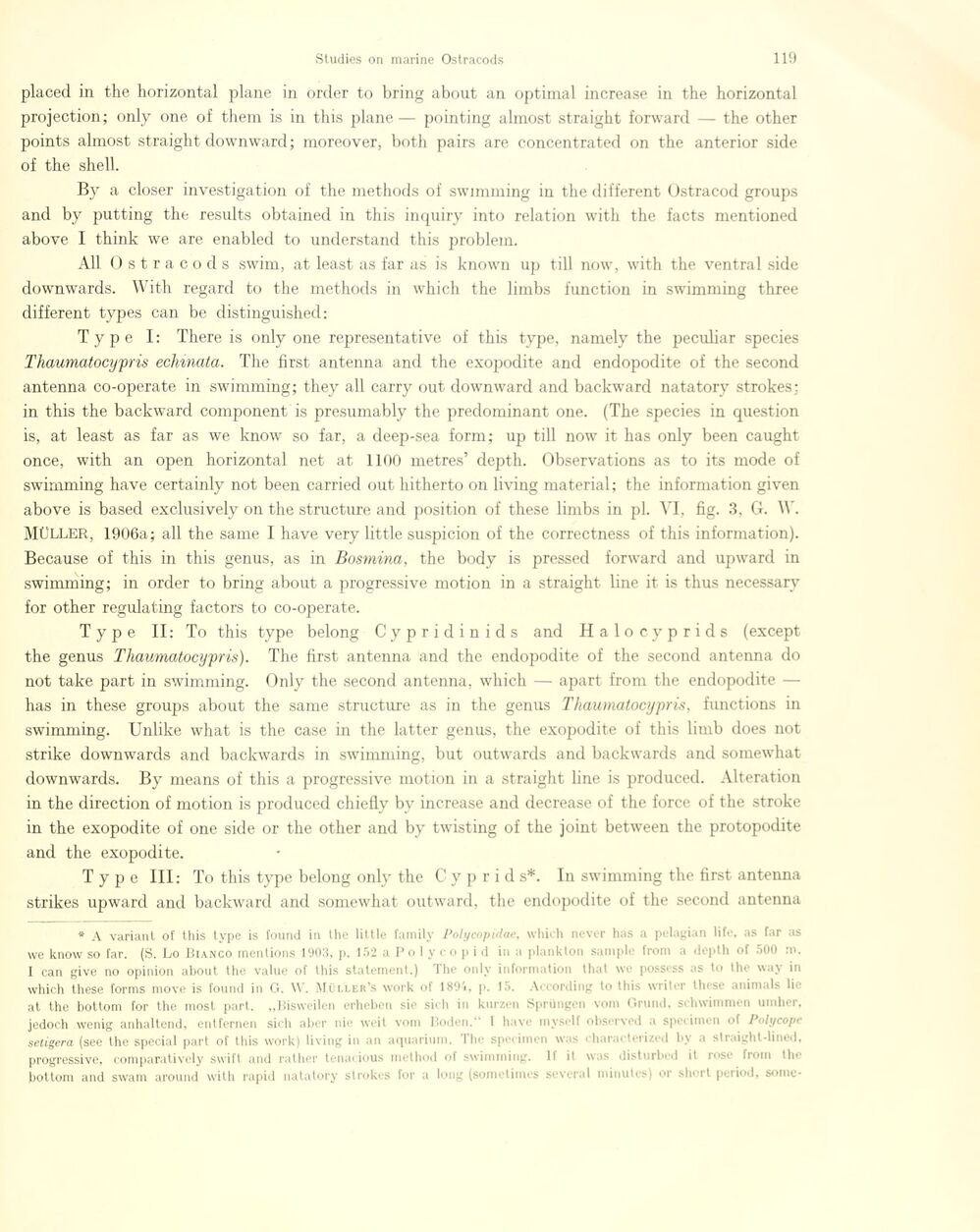
Full resolution (JPEG) - On this page / på denna sida - Sidor ...

<< prev. page << föreg. sida << >> nästa sida >> next page >>
Below is the raw OCR text
from the above scanned image.
Do you see an error? Proofread the page now!
Här nedan syns maskintolkade texten från faksimilbilden ovan.
Ser du något fel? Korrekturläs sidan nu!
This page has never been proofread. / Denna sida har aldrig korrekturlästs.
placed in the horizontal plane in order to bring about an optimal increase in the horizontal
projection; only one of them is in this plane — pointing almost straight forward — the other
points almost straight downward; moreover, both pairs are concentrated on the anterior side
of the shell.
By a doser investigation of the methods of swimming in the different Ostracod groups
and by putting the results obtained in this inquiry into relation with the facts mentioned
above I think we are enabled to understand this problem.
All Ostracods swim, at least as far as is known up till now, with the ventral side
downwards. With regard to the methods in which the limbs function in swimming three
different types can be distinguished:
Type I : There is only one representative of this type, namely the peculiar species
Thaumatocypris echinata. The first antenna and the exopodite and endopodite of the second
antenna co-operate in swimming; they all carry out downward and backward natatory strokes;
in this the backward component is presumably the prédominant one. (The species in question
is, at least as far as we know so far, a deep-sea form; up till now it has only been caught
once, with an open horizontal net at 1100 metres’ deptli. Observations as to its mode of
swimming have certainly not been carried out hitherto on living material; the information given
above is based exclusively on the structure and position of these limbs in pi. YI, fig. 3, G. W.
MÜLLER, 1906a; all the same I have very little suspicion of the correctness of this information).
Because of this in this genus, as in Bosmina, the body is pressed forward and upward in
swimming; in order to bring about a progressive motion in a straight line it is thus necessarv
for other regulating factors to co-operate.
Type II: To this type belong Cypridinids and H aloe y prids (except
the genus Thaumatocypris). The first antenna and the endopodite of the second antenna do
not take part in swimming. Only the second antenna, which — apart from the endopodite —
has in these groups about the same structure as in the genus Thaumatocypris, fonctions in
swimming. Unlike what is the case in the latter genus, the exopodite of this litnb does not
strike downwards and backwards in swimming, but outwards and backwards and somewhat
downwards. By means of this a progressive motion in a straight line is produced. Alteration
in the direction of motion is produced chiefly by increase and decrease of the force of the stroke
in the exopodite of one side or the other and by twisting of the joint between the protopodite
and the exopodite.
Type III: To this type belong only the C y p r i d s*. In swimming the first antenna
strikes upward and backward and somewhat outward, the endopodite of the second antenna
* A variant of this type is fourni in the little Family Polycopidae, which never has a pelagian lifo, as far as
we know so far. (S. Lo Bianco mentions 1903, p. 152aPoly< opid in a plankton sample from > depth of 500 m.
I can give no opinion about the value of this statement.) The only information that wc posst-ss as to the wav in
which these forms move is found in G. W. M,i ller’s work 1,1 1894, p. 15. According tothis writer these animais 11’
at the bottom for the most part. „Bisweilen erheben sie sich in kurzen Sprüngen vom Grund, schwimmen umher,
jedoch wenig anhaltend, entfernen sich aber nie weit vom Boden.“ I have mysell observed a specimen ot Polycope
seligem (see the special part of this work) living in an aquarium. The specimen was characterized by a straight -lined,
progressive, comparatively swift and rather tenacious method ol swimming. li it was disturbed it rose from the
bottom and swam around with rapid natatory strokes For a long (sometiincs several minutes) or short period, some-
<< prev. page << föreg. sida << >> nästa sida >> next page >>